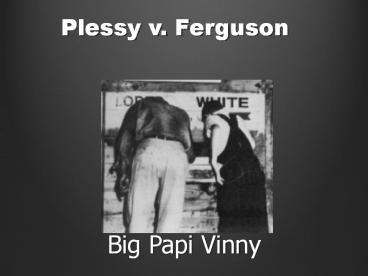Plessy v. Ferguson - PowerPoint PPT Presentation
1 / 15
Title:
Plessy v. Ferguson
Description:
Plessy v. Ferguson Big Papi Vinny In 1892, Homer Plessy took a seat in the whites only car of a train and refused to move. He was arrested, and convicted for ... – PowerPoint PPT presentation
Number of Views:429
Avg rating:3.0/5.0
Title: Plessy v. Ferguson
1
Plessy v. Ferguson
- Big Papi Vinny
2
- In 1892, Homer Plessy took a seat in the whites
only car of a train and refused to move. He was
arrested, and convicted for breaking Louisianas
segregation law.
3
- Plessy appealed, claiming that he had been denied
equal protection under the law. The Supreme Court
handed down its decision on May 18, 1896.
Homer Plessy
4
- The Supreme Court ruled that separate-but-equal
facilities for blacks and whites did not violate
the Constitution.
5
- Plessy claimed that segregation violated his
right to equal protection under the law.
6
- In the decades following the Civil War, Southern
states passed laws that aimed to limit civil
rights for African Americans.
7
- The Black codes of the 1860s, and later Jim Crow
laws, were intended to deny African Americans of
their newly won political and social rights
granted during Reconstruction.
8
- Plessy was one of several Supreme Court cases
brought by African Americans to protect their
rights against discrimination.
9
- Plessy was the most important of these cases
because the Supreme Court used it to establish
the separate-but-equal doctrine.
10
- As a result, city and state governments across
the South, and in some other states, maintained
their segregation laws for more than half of the
20th century.
11
- These laws limited African Americans access to
most public facilities, including restaurants,
schools, and hospitals.
12
- Signs reading Colored Only and Whites Only
served as constant reminders that facilities in
segregated societies were separate but not equal.
13
- It took many decades to abolish legal
segregation. During the first half of the 20th
century, the National Association for the
Advancement of Colored People (NAACP) led the
legal fight to overturn Plessy.
14
- It was not until 1954 in Brown v. Board of
Education that the Supreme Court overturned any
part of Plessy.
15
- In later years, the Supreme Court overturned the
separate-but-equal doctrine, using the Brown
decision . For example, in 1955, Rosa Parks was
convicted for violating the law and sitting in
the front of the bus.































